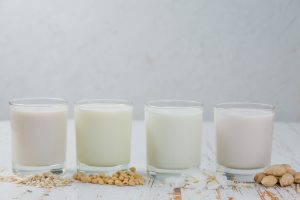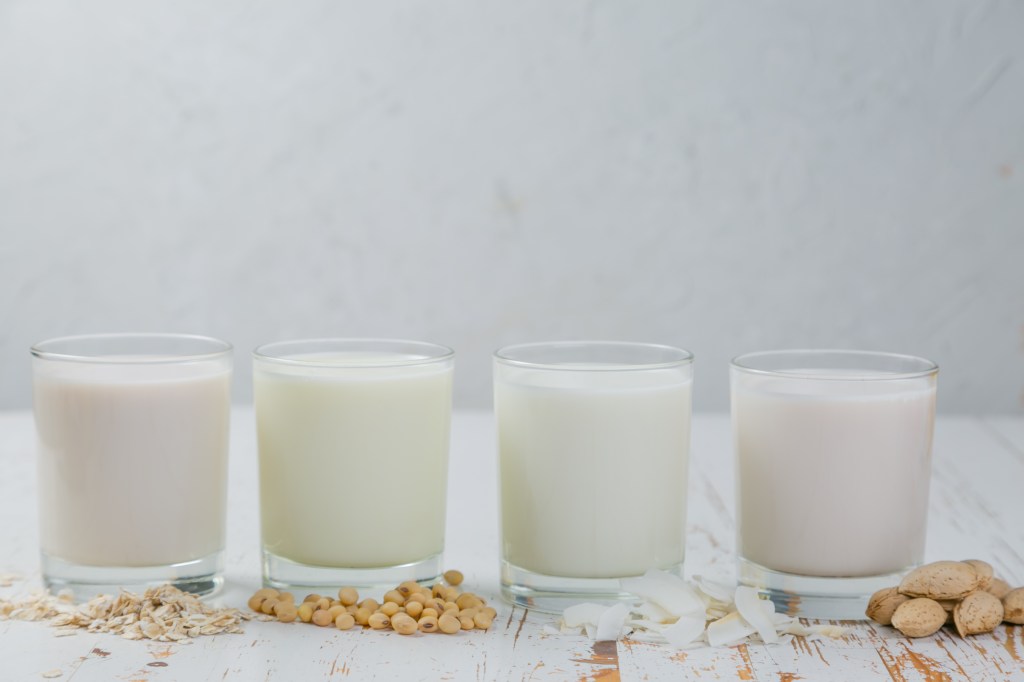
Sales of non-dairy milks are continuing to boom in Australia and around the world, but there is a growing feeling that the convenience channel is still failing to capitalise on the segment’s full potential.
The opportunity is clear. An audit carried out by the Grains and Legumes Nutrition Council (GLNC) found that the number of plant-based milk products in Australia’s four major supermarkets had grown by 58% in two years. Since the last audit in 2016, the number of coconut milk products has grown by 220%, nut milks have increased by 90%, and the legume milk category has lifted by 36%.
It’s a trend that even Dairy Australia has acknowledged. In its latest Situation and Outlook report, the organisation noted that back in 2015 sales of non-dairy ‘milks’ represented just 5.8% of total milk sales. In the 12 months to September 2018, non-dairy alternatives had grown to account for 7.9% of total supermarket milk sales by volume, and 12.4% by value.
Grocery then has reacted quickly and positively to the growing demand for non-dairy milks, stocking more product and making more sales. However, many feel that the convenience channel has not been quite as proactive.
Vitasoy which produces a popular range of plant milks – made from soy, almond, coconut, and oats – says the category is definitely under-developed in convenience. It says that while grocery plant milk retail sales exceed $300 million annually and are growing at 13% (Australian Grocery Aztec MAT 14/10/18), sales in convenience are just $1 million per annum.
“It’s a staggering difference,” said Vitasoy’s Managing Director, Chris Gillard. “The category’s growth and prevalence in Australia’s changing dietary choices means it’s important for convenience to stock it … or miss an opportunity for growth.”
The limited amount of fridge space available to most convenience and impulse operators may in part explain why the channel is ‘lagging’ in non-dairy milk, but the significant upsides of the emerging segment are that it can attract new customers, it has higher margins than fresh milk, and is easier to manage thanks to its significantly longer shelf life.
The first step towards capitalising on the opportunity is for convenience to understand the new products, and why people are gravitating towards them in such numbers.
“Many people think that plant-based milk is a niche category,” said Vitasoy’s Mr Gillard. “But the reality is that more than 35% of Australian households have bought the category in the last year.”
Non-dairy drinks are bought by a range of consumers, including those who choose to avoid dairy products due to ethical or environmental concerns. The rise in veganism explains at least some of the growing demand for non-dairy milk but it is far from the whole picture. A growing number of consumers identify themselves as flexitarian or lessitarian, meaning that they’ve cut back on their consumption of animal-based foods and beverages, and there are also consumers are looking for an alternative to dairy due to allergies or intolerance. For many others, it is the perceived health benefits that draw them to non-dairy milk. Most alternative milks are lower in energy, or kilojoules, and can contain a lot less fat than cow’s milk. However, a lot are also considerably lower in protein and calcium, and some are therefore fortified with key nutrients.
Vitasoy says consumers who enjoy plant-based milk are typically adding it to their dairy consumption rather than replacing dairy, which means overall purchase and consumption is increasing.
Plant-based milks, of course, aren’t technically milks at all. Nut milks, for example, are essentially crushed nuts with water added. It has led to a bit of a debate about whether these products should be allowed to call themselves milks. Australian dairy advocacy group, Dairy Connect, has suggested that almond milk, for example, should be labelled as ‘almond juice’ or ‘almond water’ to help consumers recognise them as separate products.
Among the most popular plant-based milks are those made from soy, almond, coconut, hazelnut, rice, oat, and macadamia. According to Dairy Australia, soy drinks make up roughly 43% of the non-dairy beverage market, while almond beverages have grown to account for more than 35% of the market.
“Consumer choice and range is really important for the convenience sector as it moves to compete with grocery as a destination for everyday purchases,” said Vitasoy’s Mr Gillard. “This includes stocking a good variety of plant-based milks for a range of consumption occasions, and we believe there is considerable growth still to come for the category generally, but more specifically, within convenience which is coming off a very low base.”
New product development is crucial to driving sales in the category, and Vitasoy says customers are increasingly looking for products that are better suited to on-the-go consumption, an area in which plant-based milks have traditionally lagged.
Vitasoy says it will continue to innovate and deliver new products and line extensions, and it believes its 330ml pack size is ideal for on-the-go consumption.
“Interestingly, flavoured plant milk is the largest segment of plant milk in convenience,” said Mr Gillard. “Non-dairy flavoured milks have mainstream appeal to a wide range of consumers for a whole host of reasons and, generally, consumption of non-dairy milks seems to be driven by consumers who love flavoured milk, but are monitoring how much dairy they consume.”
This explains why the company is so confident that its recently released Vitasoy Whole range of flavoured non-dairy milks will sell well in convenience.
“Popular milk beverage flavours married to popular plant-based milks seems obvious but was a very effective innovation,” said Mr Gillard. “Vitasoy Whole allows these consumers to enjoy more flavoured milk consumption because it is seen by these people as a healthy option with the goodness of plants.”
Other leading companies that have been enjoying good success with non-dairy milks include Australia’s Own Organic which is part of the Freedom Foods Group of brands that specialises in food focused on health and nutrition. Its products include its highly successful almond milk, as well as a coconut almond milk blend, rice milk, and unsweetened soy milk.
Similarly, Sanitarium has been seeing sales of its dairy free milks under the So Good brand soar. These include soy milk, coconut milk, almond & coconut milk, and a range of flavour variants including Almond Milk Dark Chocolate Flavoured, Almond Vanilla Coconut, and Almond Milk Date & Caramel Flavoured, .
As convenience wakes up to the potential of non-dairy milk and seeks to replicate the success the segment has had in grocery, operators needs to focus more attention on the way it is managed. Dairy-free milk producers say the most important thing that convenience can do to capitalise on the growth potential is to simply improve ranging of dairy-free milks and to better alert shoppers to the offer.
The most effective way to lift sales of dairy-free milks is to display them next to, and with, fresh cow’s milk in the dairy cabinets rather than perhaps hide them amongst the ‘super-healthy’ products. Plant-based milks are rapidly entering the mainstream, so it makes sense to us that they are merchandised prominently and in the higher traffic areas. In its latest Situation and Outlook report, Dairy Australia noted that non-dairy milks are substantially more expensive than fresh white milk, with an average retail price ranging between $2.19 a litre and $3.60 a litre. It said that among non-dairy beverages, soy drinks are generally the most affordable option while macadamia milk is the most expensive.
“Due to the high purchase price, retail data suggests customers are more likely to purchase non-dairy beverages when they are part of a promotional offer,” the reports said. “Sales generally spike as soon as the price goes down, indicating that customers demand for non-dairy alternatives is fairly elastic.”
The future then looks bright for non-dairy milks. Recent data from market research company Mintel revealed that sales of the products had grown 61% in the US over the past five years. Mintel said that while almond, soy and coconut, were still the biggest sellers, new non-dairy milk types such as pecan milk and quinoa milk were sparking excitement and driving further growth.
With the plant milk category in Australian grocery enjoying sales figures 300 times higher than in convenience, Vitasoy says the channel has a real chance to make inroads.
“It’s an exciting and rapidly evolving category and we see a huge opportunity for convenience to grow plant-based milks from their current low base,” said Vitasoy’s Chris Gillard. “With the emergence of ready to drink flavoured variants and increased consumer interest, we believe plant-based milks will become an important sales contributor for convenience.”
Watch this space.
Leading dairy-free milks
Soy milk – contains more protein than most dairy free milks. Most soy milk brands are also fortified with similar levels of calcium to dairy milk. Some also contain vitamins D, B2 and B12.
Almond milk – lower in kilojoules than dairy milk, and also low in saturated fat. It has lower amounts of protein than soy and not all brands contain similar levels of calcium to dairy milk. Varieties with no added sugar are also available.
Coconut milk – has higher amounts of saturated fat (from the coconut) and compared to many other dairy free milks, is lower in calcium and protein.
Rice milk – most brands are fortified with calcium. Rice milk is low in saturated fat, but also low in protein. It also tends to have a high level of natural sugar, almost double that of soy milk.
Oat milk – low in saturated fat but it also has lower protein. Not all oat milks are calcium-fortified and may not be suitable for those sensitive to gluten.
* Convenience & Impulse Retailing magazine would like to thank Vitasoy, the Grains and Legumes Nutrition Council, and Dairy Australia for supplying information for this article.
AT A GLANCE
- While plant milk sales in grocery exceed $300 million annually and are growing at 13%, sales in convenience are just $1 million per annum.
- More than 35% of Australian households have bought plant-based milk in the past year.
- Consumers who enjoy plant-based milk are typically adding it to their dairy consumption rather than replacing dairy
- The most effective way to lift sales of dairy-free milks is to display them next to, and with, fresh cow’s milk in the dairy cabinets.

